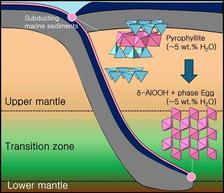An illustration depicting that water contained in clay minerals is transported to the lower mantle through breakdown reactions along the subducting plate. (Credit: Authors/Original Publication)
Nobody knows how much water is contained in the Earth’s interior. It’s 6400 kilometres from the surface to the centre, but the deepest point we can get to is mere 12 kilometres, so most estimations are based on assumptions and extrapolations about the composition of our planet’s mantle and core. A study by a research team led by Yongjae Lee from Yonsei University (South Korea), conducted at PETRA III as well as at Pohang (South Korea) and the Advanced Photons Source at Argonne National Laboratory (USA), now shows that minerals might carry more water into the Earth’s deep mantle than previously assumed.
Water affects many properties of Earth’s interior: heat, deformation, volcanic and seismic activity and more. These in turn have a direct influence on life on Earth. Knowing more precisely how water distribution across the Earth began and how it has changed over the Earth's 4.6 billion-year history might give us clues as to how it will evolve in the future.
Experiments performed at DESY’s synchrotron facility PETRA III, PLS-II at Pohang, South Korea and the Advanced Photons Source at Argonne National Laboratory, USA demonstrated that sediment minerals from Earth’s continents called clays can significantly influence the water household of the Earth’s interior. This study was conducted as part of an effort to understand how the subduction process that sends tectonic plates down to the mantle affects the global transport and distribution of water through changes in the water content contained in minerals composing the subducting plate.
The team of scientists led by Yongjae Lee from Yonsei University (South Korea) used a heated diamond anvil cell, an experimental device that can expose material to extremely high pressures and temperatures, for experiments to simulate the path clay minerals would take in a cold subduction zone, where one tectonic plate disappears into the mantle underneath another tectonic plate. They then studied the breakdown of those clays in detail. The study published in Nature Communications concludes that clays in subducting sediments are responsible for delivering up to 22% of the total water transported into the lower mantle, which is a significant amount and helps constrain the question of how much water could be in the Earth’s deep interior in total.
When continental rocks weather and break down they eventually transform into clay minerals. “Clays are layered sheet silicates that are easily transported to the ocean via rivers and make up the top most part of the oceanic plate. When these sediments are transported via tectonic movement to the edges of the continents and dive down into the Earth’s interior via the subduction process, they are exposed to elevated pressures and temperatures,” explains Yoonah Bang, lead author and former student at Yonsei University. One of the major minerals contributing to the clays in the sediments is the alumina-carrying silicate mineral called pyrophyllite (Al2Si4O10(OH)2), “Using a pressure cell consisting of resistively heated diamond anvils, we are able to simulate pressures of up to some 230,000 atmospheres and temperatures of 900 degrees Celsius to mimic the subduction path pyrophyllite will take when it dives down to the lower mantle” says Bang.
In cold subduction zones like those located in the west Pacific, pyrophyllite transforms to the minerals gibbsite (Al(OH)3) and diaspore (AlO(OH)) at a depth of some 135 kilometres. During this process, the minerals take up water from the surrounding hydrated slab and carry it down to a depth of 185 kilometres. From here sequential transformations take place to other water-bearing minerals that eventually drag the same amount of water initially contained in pyrophyllite to a depth of 700 kilometres in the lower mantle. “This shows how important it is to clearly understand the role of clay minerals during the subduction process,” explains Y. Lee, who led this work. “Our research implies that clay minerals such as pyrophyllite would have transported about 2~3% of global ocean water down to the lower mantle over 2.5 billion years.”
“The findings contribute to the overall understanding of the hydration of the Earth through its history”, says Hanns-Peter Liermann, leader of the 'Extreme Conditions Beamline' P02.2 at PETRA III, where part of the research was performed.
“Knowing how much water is transported through subduction into the Earth’s interior will in the end help us estimate how much water could really be stored in the mantle transition zone and lower mantle, constraining estimates that range from 4 to 12 times the amount of water present in all oceans, lakes, clouds etc.”, says Lee.
Previous studies have only shown that water contained in minerals escapes during subduction and leads to earthquakes and volcanic activity. However, this study shows that some clay minerals like pyrophyllite can carry water to the lower mantle through the process of being converted into high-density mantle minerals containing a larger amount of water during the subduction process.
This suggests that the role of plate tectonic movement and water-containing minerals is important in understanding and predicting the distribution of water throughout the Earth and its evolution. As the mantle and the core of the planet will not be accessible to us even in the far future, the only way to understand it’s interior will have to be indirect via such high-pressure measurements.
The work was in part supported through research efforts related to the “Center for Molecular Water Science (CMWS)” an initiative of DESY.
(partly from DESY News)
Reference:
A role for subducting clays in the water transportation into the Earth’s lower mantle, Bang, Y., Hwang, H., Liermann, H. P. et al., Nature Communications 15, 4428 (2024), DOI: 10.1038/s41467-024-48501-z







